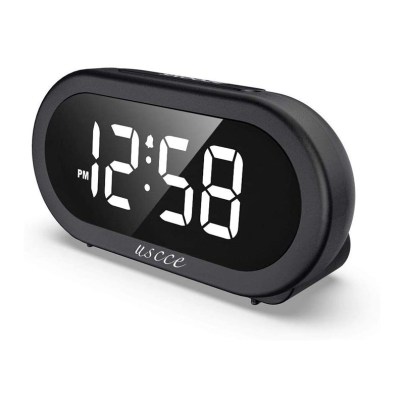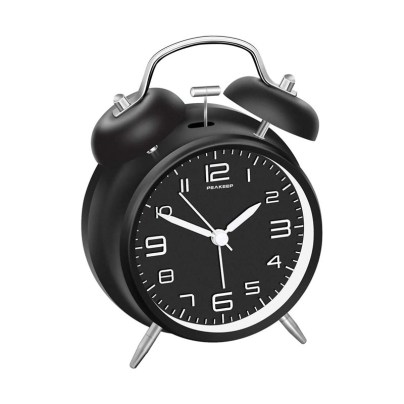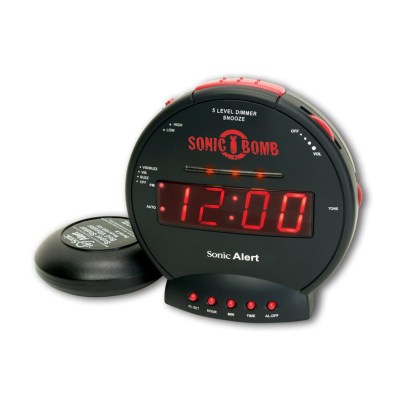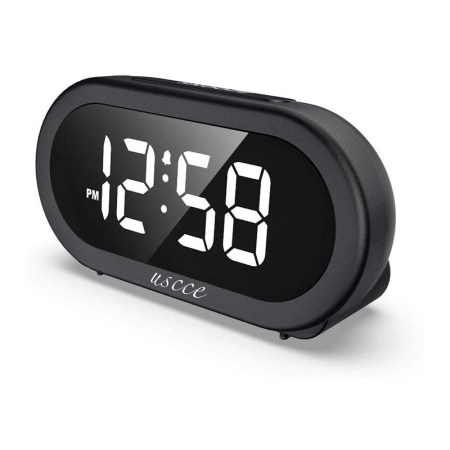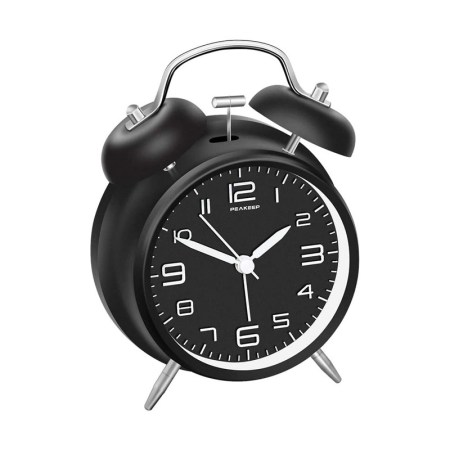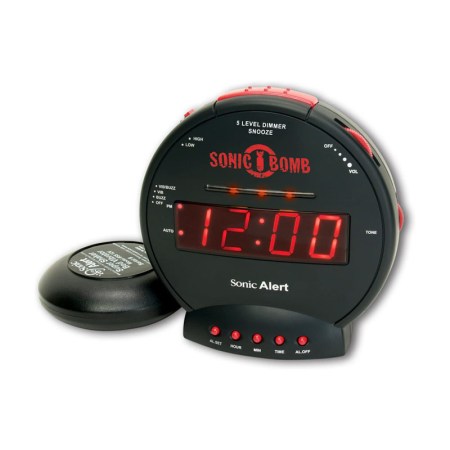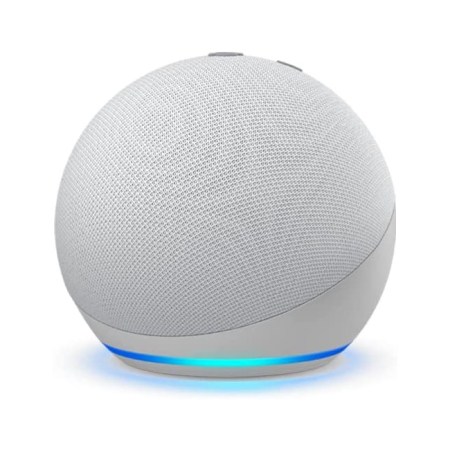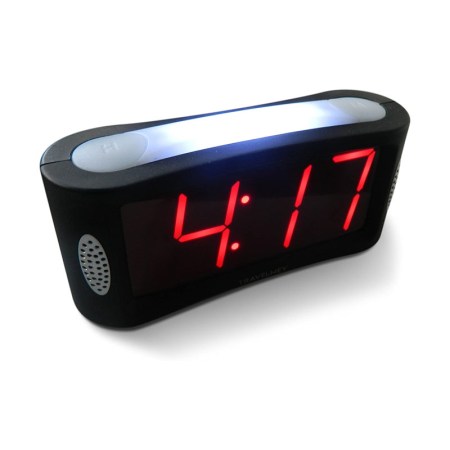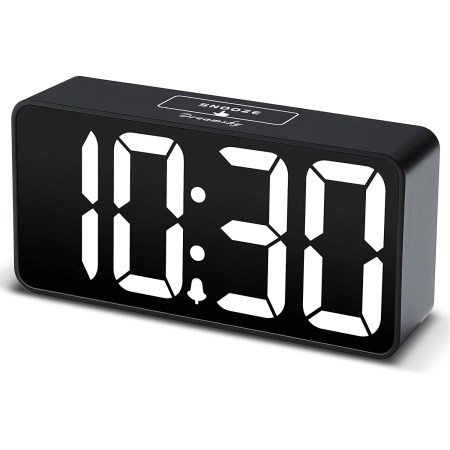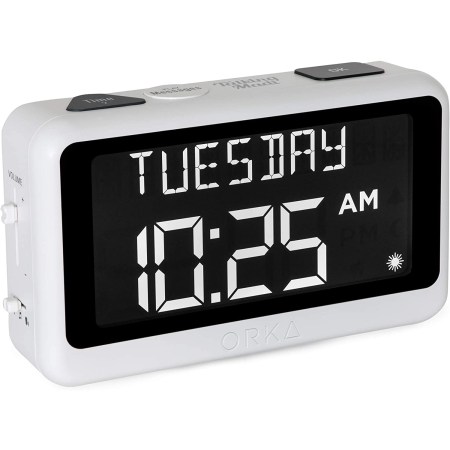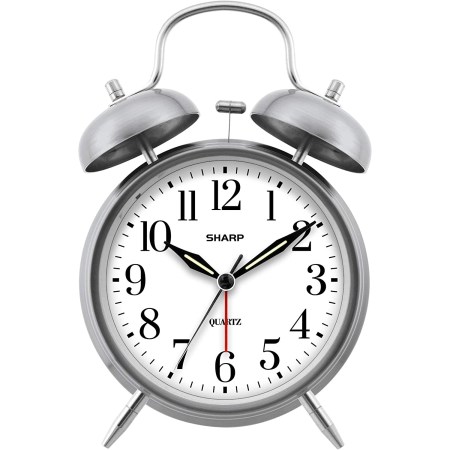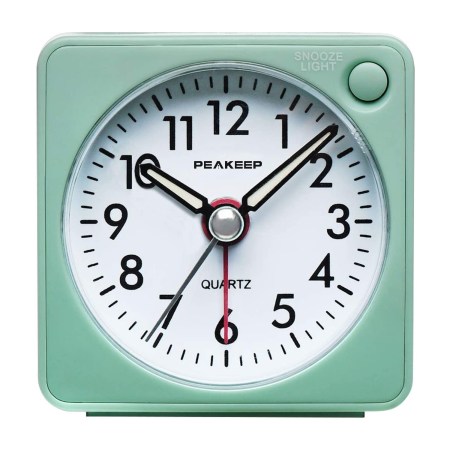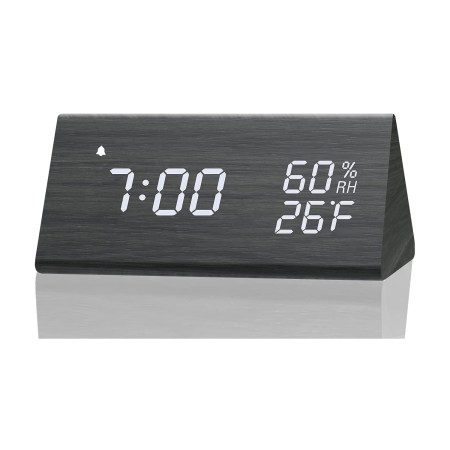We may earn revenue from the products available on this page and participate in affiliate programs. Learn More ›
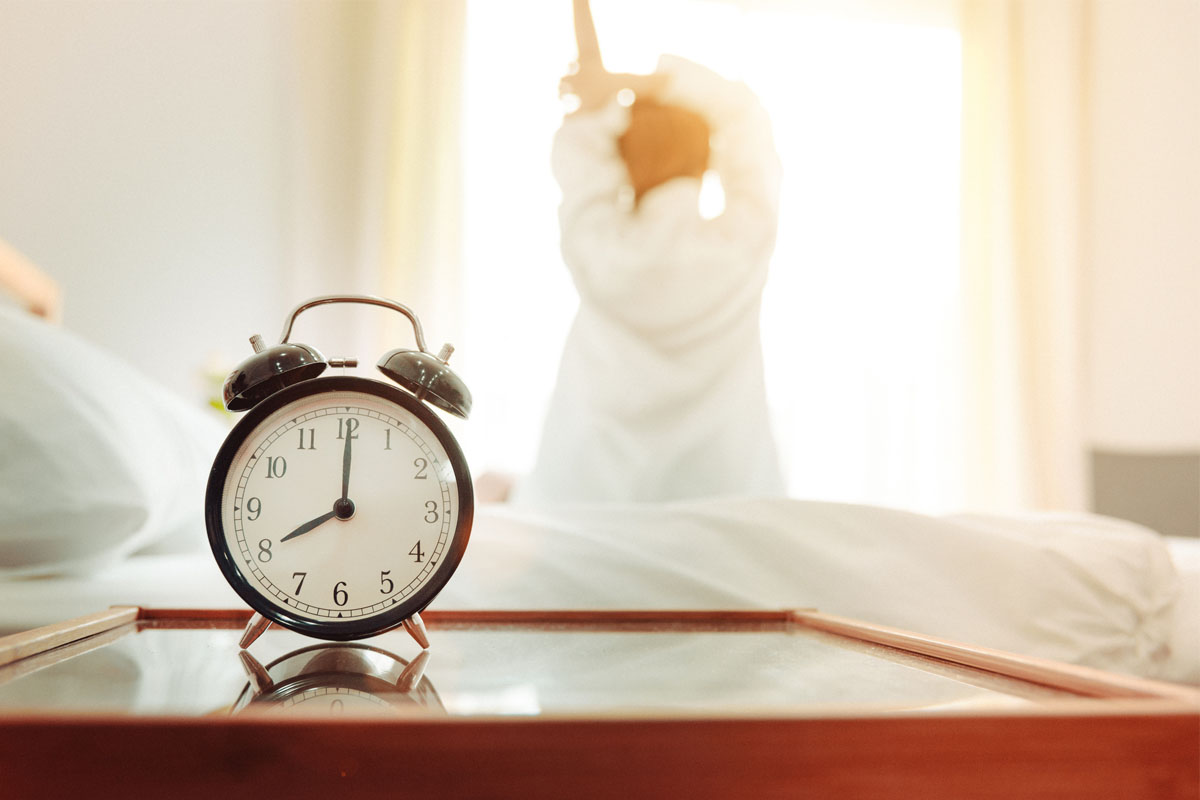
A healthier morning routine is something everyone can benefit from. Research shows that lack of sleep increases the risk for obesity, heart disease, and infections, according to the National Institutes of Health. An alarm clock that’s compatible with your sleeping style and approach to life will ease the day’s beginning, helping you get out of bed and instill good habits (and a better mood).
We’ve compared brands, studied alarm clock reviews, and discovered five stand-out unique alarm clocks that will help decrease your stress levels and increase your mojo each morning. We’ve also scoped out the various features you’ll want to be aware of before you buy.
- BEST OVERALL: USCCE Small LED Digital Alarm Clock
- BEST BANG FOR THE BUCK: Peakeep Twin Bell Alarm Clock
- BEST FOR HEAVY SLEEPERS: Sonic Bomb Dual Extra Loud Alarm Clock With Bed Shaker
- BEST SMART: Amazon Echo Dot Smart Speaker with Alexa
- BEST FOR TRAVELLERS: Travelwey Home LED Digital Alarm Clock
- BEST DIGITAL: DreamSky Compact Digital Alarm Clock
- BEST WITH MULTIPLE ALARMS: Orka Talking Digital Alarm Clock
- BEST ANALOG: Sharp Twin Bell Alarm Clock
- BEST BATTERY-POWERED: Peakeep Battery Travel Alarm Clock
- BEST-LOOKING: Jall Digital Alarm Clock with Wooden Display
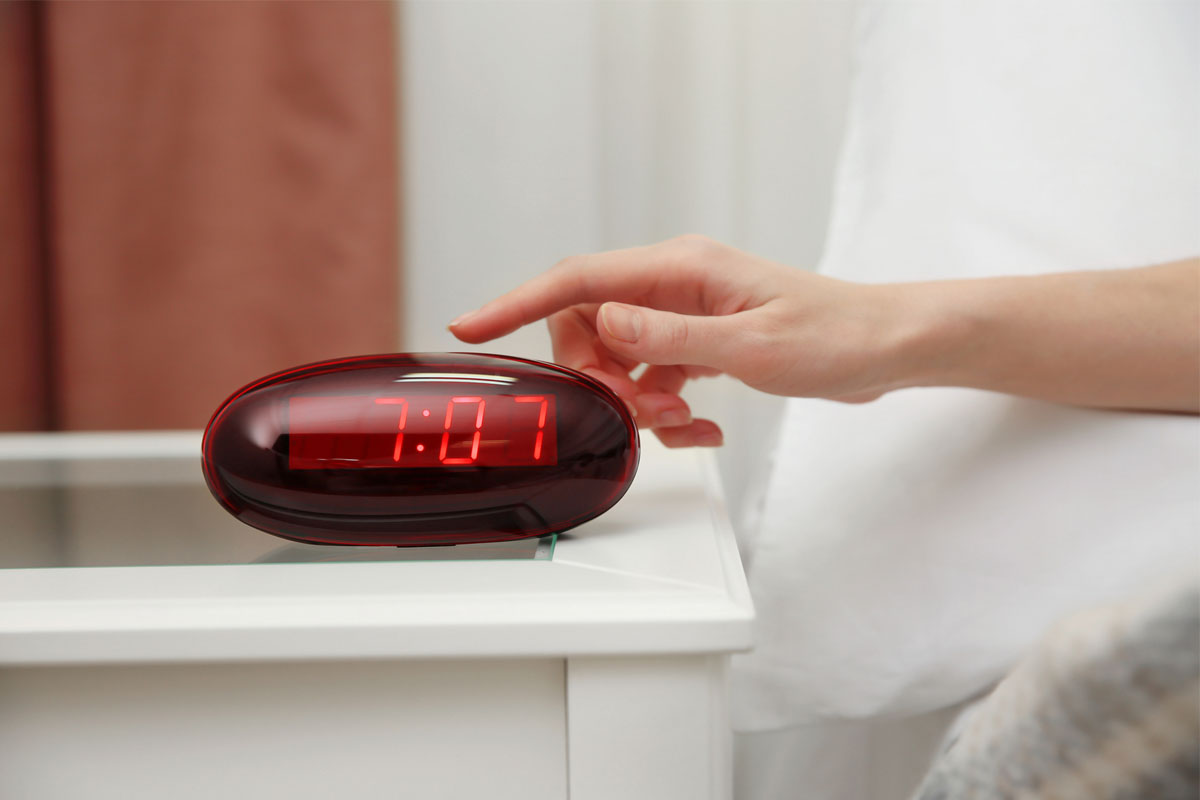
Types of Alarm Clocks
Although methods of measuring time have been around since the ancient civilizations of Sumer, Egypt, and Persia, mechanical timepieces emerged in Europe around the year 1300. Since then, inventors and horologists have continually made improvements to the accuracy and size of clocks. Today, we almost take these timekeeping innovations for granted. Clocks, however, continue to evolve, from analog models with moving hands to digital clocks that display numbers electronically to “smart” clocks that can be voice controlled and connected to the user’s digital home assistant.
Whether to choose an analog, digital, or smart alarm clock will depend greatly on the user’s sleep style, personality, and lifestyle. For example, for those who tend to be light to moderately heavy sleepers, a straightforward analog or digital alarm clock can be sufficient. Those who dread alarm clocks may want to consider a smart device that can be programmed with music or nature sounds or even a daylight clock, which uses light rather than sound for a gentler start to the day.
What to Consider When Choosing an Alarm Clock
When shopping for an alarm clock, there are a few key considerations to keep in mind: display options, alarm type, power source, and connectivity. In addition to those factors, the most important consideration is the user’s own sleep style and personality. If the clock doesn’t fit the user, it won’t be effective—it’s as simple as that.
Display
The display is the numerical face of the clock, which can be printed (analog) or electronic (digital). First, make sure the clock display is readable. Are the numbers large and bright enough to see without straining? If the answer is yes, also consider the brightness of the display and whether it is dimmable. Those who prefer a dark bedroom should look for a digital clock with dimmable numbers or an analog clock with a light button instead of a night-light alarm clock.
Alarm Types
There are four types of alarms to consider: sound, motion, or light—or a combination of all three. Each has its strengths and drawbacks depending on the user’s sleep type and preferences.
- Sound: Most alarm clocks use sound to wake us up. Many analog clocks use beeping noises, which can sometimes be adjusted for length and loudness level, typically between 30 and 90 decibels (dB), though the loudest alarms can go as high as 113 dB. Digital clocks also use sound alarms but may have more options to choose from than analog clocks, including gentler alarm sounds such as birdsong and music. Some digital clocks come with an integrated radio feature for users who prefer music or talk to wake up to. Smart clocks have the most sound features, including preprogrammed alarm options, radio channels that can be grouped as favorites, and streaming services that users can connect to via their Wi-Fi network.
- Motion: For very heavy sleepers or those who are hearing impaired, sound can be an ineffective wake-up call. Instead, consider a quiet alarm clock with a built-in “bed shaker.” This device is attached to the clock via a wire and slips under the mattress, giving the user a strong shake each morning—without waking others in the room.
- Light: Light alarms can either flash or simulate sunrise. For heavy sleepers, flashing lights can startle the brain into action. For lighter sleepers or people with sensitive ears, daylight clocks can help adjust the user’s circadian rhythms by tapping into biological cues that stimulate the brain (such as natural sunlight). These alarm clocks, which simulate dawn, appear to improve both sleep and mood, according to preliminary research. Additionally, daylight clocks are excellent for bringing light to basements or bedrooms with small windows or inadequate natural lighting.
- Combination alarms: For the heaviest sleepers or people with hearing loss or deafness, clocks that offer sound, motion, and light alarms can be the most useful. This way if one alarm fails to wake the sleeper, the other two will do the trick.
Power Source
Analog clocks are typically battery-powered. A single AAA battery can last up to 6 months, while a AA battery can last for up to 2 years of steady use. Digital and smart clocks, on the other hand, are either battery-powered or electric. Electric models are great for at-home use since the user can plug them into a bedside socket. Many digital models are also equipped with a backup battery in case of a power outage. For travelers and people on the go, having a small battery-powered digital clock can make a huge difference. By bringing their own clock, users never need to rely on hotel wake-up calls or unfamiliar and unpredictable alarm clocks again.
Connectivity
Users can find a host of smart clocks on the market, which all promise to make our lives easier and our daily routines more streamlined. Those who have a home digital assistant such as Amazon Alexa or Google Home need to make sure the clock they choose is compatible with these systems. Other features of smart clocks include integrated Wi-Fi connectivity, Universal Serial Bus (USB) ports for charging devices at night, as well as speakers and radio options. Once the clock is connected to a home network, the user can stream music, audiobooks, and news at bedtime and in the morning.
To Snooze or Not?
Many alarm clocks include a snooze button, which temporarily silences the alarm to give the user a few extra minutes of sleep before sounding again. However, users who tend to over-rely on snooze buttons should look for a nightstand clock without this handy but addictive feature.
Our Top Picks
There is a wide range of alarm clocks out there, each claiming to be the best. But which clocks really make the grade? After diving deep into reviews, research, and user-tested experiences, we’ve come up with this list of the 10 top-rated alarm clocks for users’ sleep type and lifestyle.
Best Overall
USCCE Small LED Digital Alarm Clock
See ItUSCCE’s small digital clock packs a wallop in features and functionality. The big white light-emitting diode (LED) numbers are easy to read, day or night, and the display can be adjusted from 0 to 100 percent brightness. Choose from five different alarm options, including birdsong and piano music, and adjust the volume from 30 to 90 dB (the difference between a birdcall and a motorcycle).
Though this cool alarm clock is super simple to use, it comes with additional features for the tech oriented, including an integrated USB port that can charge the user’s smartphone while they sleep. It plugs into the wall and offers battery backup in case of a power outage. Affordable without sacrificing craftsmanship, the USCCE clock is our pick for the best overall alarm clock.
Product Specs
- Display: Digital
- Number of alarms: 1
- Dimensions: 5.9 inches long by 3.11 inches wide by 1.65 inches deep
Pros
- Multiple alarm-sound options
- Integrated USB port
- Adjustable brightness and volume
Cons
- Battery backup won’t operate alarm or display
Get the USCCE alarm clock on Amazon.
Best Bang For The Buck
Peakeep Twin Bell Alarm Clock
See ItAt last, a simple alarm clock that works like a dream. For quality and simplicity, turn to the Peakeep Twin Bell Alarm Clock. With its retro style and contemporary finish, this clock will enjoy pride of place at the bedside or anywhere in the home. The clock dial is ultraeasy to read—thanks to its stereoscopic numbers—and the silent, nonticking hands mean this clock will not keep users awake at night. It will wake them up in the morning, though.
The Peakeep is designed for heavy sleepers as well as those with mild to severe hearing loss. Plus, for users who tend to ignore alarms, this clock is for them: no snooze button to rely on! Hold down the light button and the backlit face will be clearly visible at night. With five bold colors to choose from, this clock is well designed and affordable.
Product Specs
- Display: Analog
- Number of alarms: 1
- Dimensions: 6.5 inches long by 5 inches wide by 6.5 inches deep
Pros
- Loud bell ringer
- Attractive vintage look
- Silent operation with no ticking
Cons
- Only 1 alarm
- No snooze button
Get the Peakeep Twin Bell alarm clock on Amazon.
Best for Heavy Sleepers
Sonic Bomb Dual Extra Loud Alarm Clock
See ItThe name says it all: Sonic Bomb. It originated as a pioneering effort to create the first vibrating alarm clock for heavy sleepers or people who are hearing impaired. This extra-loud alarm clock is equipped with a vibrating bed shaker and flashing red lights—just in case the 113-dB range doesn’t wake the sleeper. At its loudest, this alarm clock sounds like a car horn blaring 3 feet away.
The Sonic Bomb allows the user to set multiple alarms, with a duration of 1 to 59 minutes, and a 1- to 30-minute snooze feature. Share your room with a light sleeper? Simply shut off the sound and let the bed shaker do all the work. Adjust the display brightness with a five-level dimmer. The unit comes with a battery backup and the choice of seven bright colors.
Product Specs
- Display: Digital
- Number of alarms: 2
- Dimensions: 7.2 inches long by 6.5 inches wide by 5.5 inches inches deep
Pros
- Extra-loud 113-dB alarm
- Includes bed vibrator
- Dimmable display
Cons
- Not a very attractive clock
Get the Sonic Bomb alarm clock on Amazon or at The Home Depot.
Best Smart
Amazon Echo Dot Smart Speaker with Alexa
See ItThere are minimalist alarm clocks and then there is the Echo Dot, which is capable of many more functions than simply sounding an alarm at a set time. The Echo is entirely voice controlled so there’s no messing with any buttons to set the alarm. The user can simply tell Alexa when to set a single alarm or multiple alarms with a voice command. There’s no fumbling around looking for the snooze button, either. Alexa will delay the alarm another 5, 10, or however many minutes the user commands.
Of course, Echo Dot offers far more than an alarm. The voice-activated digital assistant is capable of playing music, checking the weather, delivering the news, answering random questions, turning smart lights on and off, and executing various other smart-home features, all via voice commands.
Product Specs
- Display: Digital
- Number of alarms: Multiple
- Dimensions: 3.9 inches long by 3.9 inches wide by 3.5 inches deep
Pros
- Can set alarms and engage snooze with voice commands
- Delivers news, weather, and other online information
- Voice-activated smart-home controls
- High-quality speaker
Cons
- More expensive than traditional alarm clocks
Get the Amazon Echo Dot alarm clock at Amazon, Best Buy, or Target.
Best for Travel
Travelwey Home LED Digital Alarm Clock
See ItFrequent travelers who often worry about being late for important meetings should pack the Travelwey alarm clock. This stripped-down yet high-quality alarm clock is designed with “absolute simplicity in mind,” according to the company. The extra-large illuminated LED digits can be dimmed to the user’s personal comfort level, offering relief from electronic lights during sleep time.
With a large built-in night-light, a loud 5-minute alarm, and a 9-minute snooze button, the Travelwey is perfect for business trips and school days. Just plug it in for daily use, and pop in two AAA batteries for backup power in case of an outage.
Product Specs
- Display: Digital
- Number of alarms: 1
- Dimensions: 6.5 inches long by 2 inches wide by 2.75 inches inches deep
Pros
- Large display
- Loud alarm
- Includes a battery backup
Cons
- Only 1 alarm setting
Get the Travelwey alarm clock on Amazon.
Best Digital
DreamSky Compact Digital Alarm Clock
See ItThis alarm clock from DreamSky comes with a large 2-inch display, making the numbers visible even for those with strong prescription glasses. The 0 to 100 percent dimmer level allows the user to keep the brightness in check so the display doesn’t negatively affect sleep. There’s also a choice of seven color options.
Its single alarm setting comes with a 9-minute snooze, and the alarm volume can be set between 30 and 90 dB. There are also two USB charging ports for smart devices and a battery backup to ensure the alarm clock remains functioning in the event of a power outage. Although this alarm clock lacks some of the frills of other alarm clocks, it’s a great option for those who want a basic alarm clock at an affordable price.
Product Specs
- Display: Digital
- Number of alarms: 1
- Dimensions: 5.3 inches long by 1.4 inches wide by 2.6 inches deep
Pros
- Large 2-inch display
- Adjustable alarm volume
- Dimmer for display
- Affordably priced
Cons
- Only 1 alarm setting
Get the DreamSky alarm clock on Amazon.
Best With Multiple Alarms
Orka Talking Digital Alarm Clock
See ItMost alarm clocks allow users to set one or two alarms, but this model from Orka offers up to eight individual alarms, making it ideal for those who need daily reminders for taking medications. Since that many alarms can be confusing, the clock allows the user to create a voice recording for each alarm explaining what the alarm is for. The alarms can be set for daily or weekly reminders.
In addition to time, the display also shows the day of the week, which appears on a large, easy-to-read display. The alarm is also designed for those who are hearing impaired, with volume controls that reach up to 90 dB and a display that flashes when the alarm goes off. The controls are large and easy to use for those with mobility issues. There’s also a handy USB charger integrated into the clock for smart devices.
Product Specs
- Display: Digital
- Number of alarms: 8
- Dimensions: 9.6 inches long by 2.7 inches wide by 5.7 inches inches deep
Pros
- Can set up to 8 alarms
- Can make voice-recorded alarms
- Alarm flashes for those with hearing loss
- Easy-to-use controls
Cons
- Expensive compared to other alarm clocks
Get the Orka alarm clock on Amazon.
Best Analog
Sharp Twin Bell Alarm Clock
See ItThose who want to wake up to the vintage sound of the classic two-bell alarm clock should consider this model from Sharp. It consists of simple controls that allow the user to set the current time and the alarm time. A switch engages the alarm while a button turns the backlight on and off.
When the alarm sounds, a small hammer rapidly hits both bells, creating a loud ringing designed to awaken even heavy sleepers. Unlike traditional analog alarm clocks, the Sharp alarm clock functions silently with nonticking hands. At just 4.6 inches in length, 2.2 inches in width, and 6.5 inches in height, this alarm clock takes up little space on the nightstand and is available in five color options.
Product Specs
- Display: Analog
- Number of alarms: 1
- Dimensions: 4.6 inches long by 2.2 inches wide by 6.5 inches inches deep
Pros
- Easy to set
- Loud ringer
- Attractive vintage look
- Silent operation with no ticking
Cons
- No snooze button
- Only 1 alarm
Get the Sharp alarm clock on Amazon.
Best Battery-Powered
Peakeep Battery Travel Alarm Clock
See ItWith a size that makes it small enough to fit inside a pocket, this model is ideal for those looking for an alarm clock to take on the road. It measures just over 2 inches in length and height and weighs about 2 ounces.
Despite its compact size, it comes with all the necessary features one needs in an alarm clock. The analog display is backlit for nighttime viewing, and the alarm gently awakens the user by slowly increasing in volume until it’s turned off. Two easy-to-operate dials allow the user to set the current time and the alarm. A small button on the upper-right-hand corner of the alarm turns the backlight on or engages the snooze function. The clock also doesn’t require a power outlet, instead running on a single AA battery.
Product Specs
- Display: Analog
- Number of alarms: 1
- Dimensions: 2.25 inches long by 1.25 inches wide by 2.25 inches deep
Pros
- Compact size for travel
- Backlight for nighttime viewing
- Battery-powered
- Ascending 4-stage alarm
Cons
- No alternating current (A/C) power option
Get the Peakeep travel alarm clock on Amazon.
Best-Looking
Jall Digital Alarm Clock with Wooden Display
See ItMost alarm clocks have a utilitarian look that does little to add to the aesthetics of one’s bedroom. That’s not the case with this wooden alarm clock from Jall. Available in four finish options, it features a triangular-shaped wood block design with a digital display that looks similar to that of popular smart speakers. The alarm and clock are set via touch controls on the alarm’s display, which can be adjusted for brightness with a dimmer.
In addition to its stylish design, the Jall alarm clock also sets itself apart with functions not typically found on an alarm clock. It allows the user to set three alarms and displays room temperature and humidity. The clock uses a USB cord for power but does not have a battery backup.
Product Specs
- Display: Digital
- Number of alarms: 3
- Dimensions: 4.72 inches long by 1.97 inches wide by 1.97 inches deep
Pros
- Attractive modern look with wood finish
- 3 alarms
- Touch-screen controls
- Tells temperature and humidity
Cons
- No battery backup
Get the Jall digital alarm clock on Amazon.
Our Verdict
With its ability to play five different sounds ranging from music to birdsong and its ease of use, the USCCE alarm clock is the best overall alarm clock we reviewed. Heavy sleepers looking for an alarm clock that’s nearly impossible to sleep through should consider the Sonic Bomb alarm clock, which is extra loud at 113 dB.
How We Chose the Best Alarm Clocks
We used several criteria to create our list of the top alarm clocks. An alarm clock’s primary function, of course, is to wake up the user, so we chose models that meet or exceed 90 dB, the equivalent of a lawn mower. An alarm clock should be easily readable, even for those with strong eyeglass prescriptions, so we limited our selections to alarm clocks with large displays. We also leaned toward alarm clocks that offered the most features, including number of alarms, volume controls, sound options, and adjustable backlights. Finally, we went with clocks that are compact enough to sit on a nightstand without hogging space.
FAQs
Shoppers still might have some questions about which alarm clock is right for them. Read below to find the answers to some of their most frequently asked questions.
Q. Which alarm clock wakes you up the best?
With sound options that are more soothing than a standard alarm clock and alarms that gradually increase in volume, the USCCE alarm clock does the best job of waking you up without jarring you out of sleep.
Q. How do I choose a good alarm clock?
To select a good alarm clock, choose one that suits your needs. If you need a basic alarm clock, go with one that offers a single alarm with simple controls and an affordable price. If you want a clock that can provide you with more features, consider going with a digital assistant. If you live in an area prone to power outages, get a dependable alarm clock that has a battery backup. Make sure the display is large enough so you can easily read it from bed even without your glasses. Finally, choose a clock with a volume high enough to wake you up.
Q. Which alarm clock is the loudest?
With its 113 dB alarm and bed vibrator, the Sonic Bomb alarm clock is the best option for heavy sleepers.
